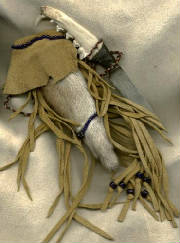|

The paw came from a "roadkill" some idiot snowmobilers left on the pond one winter. They ran the poor coyote down
while she was caught out on the ice and then just left the body there where little kids could find it. A friend of ours lives
on that pond. He called us to ask what the dead animal was. Was it a dog, coy-dog, coyote or a wolf? Nobody knew the difference.
We went over to look at it. It was a young female coyote after all. I brought her home, hoping to salvage what I could. Unfortunately
she had been out in the sun too long before people found her. I got a few bones, the skull and three paws. Never did find
the fourth. Stuck in someone's snowmobile tread probably.
I kept the paws and dried them because I had seen a neat knife with a coyote paw for a handle and a bone blade. But I
never got around to making one. Now this fore-paw said it wanted to be a sheath instead, so I soaked it just long enough to
get the long bones out and free up the skin. I split the paw down the back as I went as far down as I could, which came to
just above the center paw pad. I could not get it to go any further. I then tanned it using a commercial solution.
I found some rawhide and made a sheath to fit the knife blade. This consists basically of two long triangles sewn together
with a strip "welt" to protect the seams. I then fit the rawhide piece into the paw, found a piece of commercially
tanned deerskin and stitched it all together with the paw fur on front and the deerskin in back. Another scrap of deerskin
was sewn around the top to hide the edges. I put on a hanging loop in back, cut the fringe and added some glass beads. The
knife fits well and looks great.
The red, white and black yard around the knife keeps the blade from slipping out. I tie the yarn around my belt, right
beside the hanging loop on the sheath, and it stays put. In the renaissance faire, this is called "peace tying"
your weapon. The blade cannot be drawn unless it is first untied. A very good practice. I do it mostly because the knife tends
to fall out when I take the belt off. The yarn actually came from a necklace that I remade. It used to have a bear claw hanging
from it, but I took the claw to make another necklace and just saved the string. How's that for recycling?
|
 |
|
|
|
 |
|
Note on Paws:
It is usually best not to let paws dry with the bone still in unless you are absolutely certain this is how they will
be used. The tendons connecting bone and skin are very tough. It is difficult to rehydrate a dried out foot, take the skin
up and cut off the bones without damaging anything.
If you wish to save a foot bone-in but are not sure you want it to dry that way, just wrap it in a few layers of newspaper,
put it in a Zip-Loc bag and stick it in the freezer. That way if you wish to take the bones out later, the paw will still
be workable.
It is a good idea also to skin out the paw and remove as much of the meat as possible before allowing it to dry. That
way there is less chance that it will go rancid. A light coat of borax inside will deter bacteria enough to dry the paw without
problems. Pull the skin back up over the bones while it is still wet, wrap a rubber band around the end if necessary to keep
the skin in place, then let it dry in a warm spot with good air circulation. The skin will shrink tight to the bone as it
dries. If protected from insects and excessive humidity a dried paw will last a really long time.
|
 |
|
|
|

